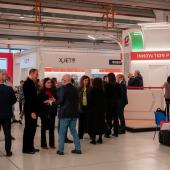The little attention paid to the evidence of facts
Editorial by Stefano Lavorini
Good day to you all, can you hear me well? This is the classic prelude to any assembly meeting, made by the speaker to call attention to what he or she intends illustrating to the audience.
Capturing the attention of the public, communicating facts and evaluations, stimulating reflection is always an undertaking. In particular today, immersed as we are in the communicative flow that, due to excess and redundancy, is often experienced as an unavoidable background noise.
In this babble of lost stimuli, not even evidence finds space, despite the fact that in itself it has some value of objectivity; because everything by now is the expression of an opinion, it is a pure exercise of critical subjectivity, if not the “bleating” reproposition of clichés.
I found confirmation of this conviction of mine taking part at the works of the last annual Gifco Congress, held in May at Baveno (VB), that touched transversal arguments while presenting, in particular in some cases, well constructed analyses, figures and facts, interesting food for though from which to depart for a reading of what is going on and what needs to be done…
In the political field, thanks to Nando Pagnoncelli of Ipsos, who presented the analyses of the electoral flows (of note those of the 5 Star Movement, whose electors derive 31% from the centre right, 30% from the centre left, 36% form abstention and the new vote) and the macrophenomenon that featured in the 2013 political elections. Summing up the tables and graphs, figures at hand, one sees “the inevitability” of the current government in power led by Enrico Letta: «When it comes down to it we are facing a tripolar political arena almost equally divided out, with a further quarter as a less important player. The two big parties have profoundly modified their constituencies. It is not so much a question of governability, that though is the theme that torments everyone in this moment in time, but one of representation. The theme of recomposition goes back to being central».
In the social field, regarding some problems that are little considered but highly explosive, such as safety. To understand one can start off from this figure: in 2012, compared to 654 thousands accidents at work, 509 of which mortal, few people consider that in the domestic environment 4.5 million accidents took place with 8 thousand deaths. The enormity of this figure has led Vittorio Terriero of Ceper to commit himself to the promotion of the Safety Bridge project «for the transfer of hazard prevention from the workplace to the domestic environment, using the awareness, knowledge and capacity of all company personnel».
In the context of food safety, in reference to the current regulation that seems not to dedicate sufficient attention to the role of packaging for fresh produce as a potential vehicle for pathogenous and degrading microorganisms. It is enough to say - Rosalba Lanciotti of the University of Bologna explained to us - that, what with the increase in food toxinfections «the critical analyses of the literature indicated the absolute lack of figures on the actual effects of packaging as a source of micro-organisms in foods», opening promising spaces for research and for a “different way of competing” between materials and types of packaging used in this market.
In the world of packaging, where the data provided by Gifco, whose members represent a bit more than 90% of the market, gives and exact picture of the production of corrugated cardboard in Italy (except, perhaps, for types and quantities of used paper, where estimates are made on a sample basis).
And hence, over and above the forecasts announcing the end of the crisis - so far systematically seen to be false - what we can be sure about is that in 2012 6.150 billion square meters of corrugated cardboard were produced in Italy, a decrease of 3.31% compared to the previous year while constituting an even more significant gap from the top figures of 2007, that one cannot imagine will be bridged in 1 or 2 years. In terms of tonnage, the decrease has been 3.88%, but this fact is linked to the reduction of average basis weight which is progressing year after year (the 0.5% difference between the two figures is indeed equivalent to about 20 thousand tons less cardboard, or that is half the annual production of a medium capacity works).
Nevertheless, according to president Piero Attoma «considering trends in other industries, things are really not that bad and we only end up by “crying out of one eye” thanks to the fact that we mainly serve the food and beverage market. Furthermore, the data for the first four months of 2013 shows a drop of less than 1%, opening up some small hope for the future».
No one can say how things will work out: the only certainty we have is that Attoma has been re-elected to the presidency of Gifco to at least May 2014.
Best of luck.
For further information Convegno annuale Gifco 2013. Ecco le relazioni

















